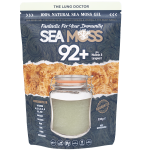
trees now planted
MULLEIN

Mullein is an ingredient in our The lung doctor blend, below you will find fascinating information and key benefits about this ingredient.
Mullein has been used in traditional medicines for millennia to treat respiratory conditions. It is both an expectorant and a demulcent, which makes it particularly good at ridding the body of mucus and soothing inflammation. It has also been used to ease joint pain, strengthen the bladder and treat skin conditions.
Mullein, also known as verbascum, encompasses over 350 species of flowering plants, native to Europe and Asia but now found in many other parts of the world. It has been used in traditional medicine for thousands of years, predominantly as a treatment for respiratory, gastrointestinal and skin conditions.
It is often used to treat asthma, bronchitis, the common cold and COPD because mullein is an expectorant, which means that it helps the body to get rid of mucus. It is also a demulcent, throwing an anti-inflammatory shield over areas affected by mucus build-up. This makes mullein very effective at soothing inflamed lungs and throats. In the 19th century, it was a popular treatment for tuberculosis, a severe respiratory disease, in the US, the UK and Europe.
There is also evidence that mullein has both antiviral and antibacterial properties, so it is great for fighting off infections. Due to this, mullein flower is often used in conjunction with garlic and St John’s Wort in ear infection medicines.
Mullein contains saponins, which aid its anti-inflammatory powers. This is why mullein can also be used to relieve joint pain from gout, rheumatism and arthritis. Mullein root has also been known to strengthen bladder muscles and used to treat incontinence and even conditions like cystitis.
Oil extracted from mullein flower is also used to treat skin conditions such as eczema and burns and injuries. Its anti-inflammatory and demulcent properties make it especially good for soothing skin affected by heat and swelling.
Key benefits of mullein include:
- Anti-inflammatory and Antioxidant Effects: Mullein contains various compounds, including flavonoids, that have anti-inflammatory and antioxidant properties. These properties can help reduce inflammation and oxidative stress in the body, which are implicated in the development of chronic diseases and even some cancers.
- Ear Infections: Mullein oil has been used traditionally for ear infections and earache relief. Mullein oil can possess antimicrobial properties and could help alleviate ear pain and inflammation associated with ear infections.
- Pain Relief : Mullein has antinociceptive properties along with its anti-inflammatory activity, mullein is a good supplement to help manage the pain of certain inflammatory conditions.
- Respiratory Health: Mullein has been traditionally used to support respiratory health. Mullein extracts can possess expectorant and cough-suppressing properties, which help alleviate respiratory symptoms associated with conditions such as bronchitis, asthma, and coughs.
- Skin Health: Mullein has been used topically for various skin conditions, such as wounds, burns, and inflammatory skin disorders. It is believed to possess antimicrobial and anti-inflammatory properties that could promote wound healing and reduce skin inflammation.
Mullein, a flowering plant often used in herbal remedies, may not be suitable for individuals with certain allergies or medical conditions. Here are some considerations:
- Allergies: Some individuals may be allergic to plants in the Scrophulariaceae family, to which mullein belongs. Allergic reactions to mullein can manifest as skin irritation, itching, rash, or respiratory symptoms such as sneezing or difficulty breathing. If you have known allergies to plants in this family, it's advisable to avoid mullein or consult with an allergist before using it.
- Asthma: Mullein may irritate the respiratory tract in some individuals, potentially triggering asthma symptoms or exacerbating existing respiratory conditions. People with asthma should use mullein cautiously or avoid it altogether to prevent respiratory discomfort or worsening of symptoms.
- Pregnancy and Breastfeeding: Limited information is available regarding the safety of mullein during pregnancy and breastfeeding. Due to potential risks, including uterine stimulation or adverse effects on the fetus or nursing infant, pregnant or breastfeeding individuals should consult with a healthcare provider before using mullein.
- Hormonal Disorders: Mullein contains compounds that may have hormonal effects. Individuals with hormonal disorders such as estrogen-sensitive conditions (e.g., breast cancer, uterine fibroids) should use mullein cautiously or avoid it due to its potential hormonal activity.
- Blood Sugar Regulation: Some herbalists suggest that mullein may affect blood sugar levels. Individuals with diabetes or hypoglycemia should monitor their blood sugar closely when using mullein and consult with a healthcare provider to ensure it is safe for them.
- Medication Interactions: Mullein may interact with certain medications, including blood thinners (anticoagulants) and drugs metabolized by the liver. It's essential to consult with a healthcare provider before using mullein alongside these medications to prevent potential interactions or adverse effects.
- Urinary Tract Disorders: Mullein is sometimes used to support urinary tract health, but individuals with urinary tract disorders such as kidney stones or urinary tract infections should use mullein cautiously and consult with a healthcare provider before use.


